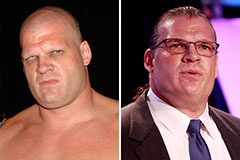The WWF Championship Belts hold a distinct and fabled location in the record of professional wrestling. Greater than simple accessories, these substantial signs of triumph represent the peak of accomplishment, the conclusion of blood, sweat, and tears dropped within the settled circle. For years, the view of a wrestler raising a gleaming WWF (later copyright) championship belt above their head has been an famous photo, instantly recognizable also to those with only a passing experience with the sporting activity. These belts are not simply prizes; they are physical symptoms of stories, heritages, and the ever-evolving landscape of professional fumbling.
The background of WWF Championship Belts is as abundant and vibrant as the business itself. From the very early days of the Globe Wide Fumbling Federation (WWWF) and its inaugural championship, the lineage of these titles tells a compelling narrative of fumbling's development and transformation. The original WWWF Championship, held by the famous Friend Rogers, was a fairly straightforward layout, a unlike the intricate and typically personalized belts of today. Yet, it laid the foundation for a practice of symbolic hardware that would certainly pertain to define wrestling excellence.
As the WWWF transitioned right into the WWF under Vince McMahon Sr. and later on his child, Vince K. McMahon Jr., the champion belts evolved in tandem with the business's burgeoning popularity. The "Big Eagle" belt, identified with the Hulkamania era, ended up being an promptly well-known symbol of fumbling's mainstream development in the 1980s. Its big, magnificent eagle design, commonly draped over the wide shoulders of Hunk Hogan, illustrated the larger-than-life personalities and growing popularity of the moment. This period cemented the championship belt as a essential storytelling gadget, a graph of prominence and the supreme reward that every wrestler aspired to achieve.
The 1990s ushered in a brand-new age for the WWF, marked by a change in wrestling design and the development of brand-new superstars. This period also saw the introduction of brand-new WWF Championship Belts, mirroring the changing aesthetic and the personalities holding them. The "Winged Eagle" belt, with its even more elaborate style including multiple plates and a prominent winged eagle, came to be the symbol of champs like Bret Hart, Shawn Michaels, and Rock Cold Steve Austin. This design is frequently taken into consideration among one of the most legendary and precious in wrestling history, standing for a golden age for the company and its top title.
The Perspective Age, a duration of edgier storylines and defiant characters, brought with it better development in the layout of the WWF Championship Belts. While the "Winged Eagle" continued to be for a time, the introduction of the "Smoking Skull" belt, particularly created for Stone Cold Steve Austin, marked a departure from practice. This unique belt, including a skull with smoke emanating from its eye outlets, highlighted the defiant and anti-establishment persona of one of fumbling's largest stars. It demonstrated the firm's desire to customize the championship to fit the character, additional boosting the storytelling capacity of the title.
The turn of the millennium and the ultimate rebranding of the WWF to copyright saw better versions of the championship belts. The "Undisputed Championship" period, adhering to the procurement of copyright, introduced a brand-new style that merged the WWF and copyright World Heavyweight Championships. This belt, while at first representing a marriage, eventually paved the way to the "Spinner" belt, famously associated with John Cena. This debatable design, featuring a large copyright logo that can rotate, was both lauded and criticized for its fancy and unconventional look. No matter opinion, it became synonymous with Cena's leading regime and the era he specified.
Beyond the major world champion, the WWF Championship Belts encompass a series of titles, each representing a various degree of achievement and field of expertise within the business. The Intercontinental Champion, typically considered the "workhorse" title, has a long and distinguished background, held by lots of future world champions. 1 Its different layouts for many years have actually mirrored its importance as a tipping rock to the main event. Likewise, the USA Championship ( originally a copyright title brought over after the purchase), the Tag Group Championships (with their numerous and frequently aesthetically distinct layouts standing for wwf championship belts the unity of a group), the Female's Championships ( advancing through various designs showing the growing prominence of women's fumbling), and the different "hardcore" and "European" titles (though now obsolete) all add to the abundant tapestry of WWF/copyright champion background.
1.
The respected history of the Intercontinental Champion: copyright, Aug. 12, 2022.
www.youtube.com.
The design and building and construction of WWF Championship Belts are considerable aspects of their attraction. Usually crafted from metal plates ( usually zinc or brass) and natural leather bands, these belts are tangible icons of reputation and workmanship. The detailed describing on the plates, including firm logos, eagles, worlds, and other symbolic images, contributes to their visual appeal and historical significance. The weight and feeling of a champion belt are usually explained by wrestlers as including in the feeling of accomplishment and legitimacy related to holding it.
The heritage of WWF Champion Belts extends far beyond the wrestling ring. They have become cultural symbols, appearing in films, television programs, and video games. Replicas of these belts are very searched for by fans, functioning as substantial suggestions of their preferred wrestlers and memorable ages. The image of a champ proudly showing their belt is deeply embedded in popular culture, representing victory and accomplishment in a more comprehensive feeling.
Finally, the WWF Champion Belts are even more than just decorative devices. They are potent signs of battling history, representing the victories and tribulations of plenty of professional athletes who have actually pursued achievement within the squared circle. From the simple layouts of the early days to the elaborate and personalized belts of the modern era, these titles have advanced alongside the company, reflecting its changing landscape and the larger-than-life individualities that have held them. The legacy of these belts continues to sustain, captivating followers and solidifying their place as legendary icons of expert fumbling excellence.
 Neve Campbell Then & Now!
Neve Campbell Then & Now! Mason Reese Then & Now!
Mason Reese Then & Now! Lynda Carter Then & Now!
Lynda Carter Then & Now! Kane Then & Now!
Kane Then & Now! Christy Canyon Then & Now!
Christy Canyon Then & Now!